Pheromone facts for kids
Pheromones are special scents that animals use to communicate with each other. These scents cause a certain reaction in other animals of the same kind. Think of them as secret messages carried by smell!
Animals use different types of pheromones for many reasons, such as:
- Finding a partner: Some animals release scents to attract a mate. Butterflies and moths are good examples.
- Warning others: Wasps might release an alarm scent to tell their group about danger.
- Showing the way to food: Ants use pheromones to create a trail to food sources.
- Marking their space: Cats and dogs use scents to show what area belongs to them.
- Quick actions: Some pheromones cause fast, short-term behaviors, like getting ready to mate.
Animals don't learn how to use pheromones; it's something they know by instinct from birth. Pheromones are found in most animals, but they are very easy to see in insects.
Contents
How Animals Use Pheromones
Gathering Together
Some pheromones help animals gather in one place. These are called aggregation pheromones. They help animals find partners, work together to overcome challenges (like attacking a plant in large numbers), or protect themselves from predators. When many animals gather in one spot, it's called an aggregation. These scents are very powerful, even in tiny amounts.
Sending an Alarm
When an animal is attacked, some species release a special scent to warn others. This alarm pheromone can make other animals of the same kind run away (like aphids) or become aggressive (like ants, bees, or termites). For example, a type of wasp called Vespula squamosa uses alarm pheromones to tell others about a threat.
Even plants can use alarm pheromones! When some plants are eaten by an animal, they release scents that tell nearby plants to produce chemicals called tannins. These tannins make the plants taste bad, so the animal stops eating them.
Marking Territory
Animals use territorial pheromones to mark the edges of their space. They leave these scents in their environment. For example, cats and dogs often spray urine on landmarks to show where their territory begins. Some seabirds also use a special gland to mark their nests and territory boundaries with scents.
Finding Food Trails
Social insects, like ants, often use trail pheromones. Ants leave a scent trail made of special chemicals as they return to their nest with food. This trail helps other ants find the food source. As long as there is food, ants will keep refreshing the pheromone trail. The scent fades quickly, so it needs to be renewed often.
If the food supply starts to run out, the ants stop making the trail. Some ants even mark trails that no longer lead to food with a repellent scent, telling others to stay away. A type of ant called Eciton burchellii uses pheromones to mark and keep their foraging paths.
Wasps like Polybia sericea also use pheromones to guide their colony to new nest sites. Even caterpillars, like the forest tent caterpillar, lay down pheromone trails to help their group move together.
Finding a Partner for Reproduction
In animals, sex pheromones tell others that a female is ready to have babies. Male animals can also release pheromones that share information about their species.
Many insects, including ants, moths, bees, and butterflies, release sex pheromones to attract a mate. Some moths and butterflies can even sense a potential mate from as far away as 10 kilometers (about 6 miles)!
Pheromones are also used to detect when female pigs are ready to breed. Sea urchins release pheromones into the water, sending a chemical message that makes other urchins in the area release their eggs and sperm at the same time.
Other Types of Pheromones
Pheromones have many other jobs too:
- Nasonov pheromones: Used by worker bees to guide other bees.
- Royal pheromones: Released by queen bees to control the colony.
- Calming pheromones: Used by some mammals to make others feel safe and calm.
- Necromones: These are scents given off by dead animals. They help other animals, like crabs and insects, know that a fellow animal has died.
Images for kids
See also
 In Spanish: Feromona para niños
In Spanish: Feromona para niños




